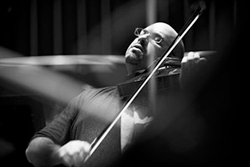by Daniel Hathaway
Newly
The program was presented on Thursday evening in Kulas Hall, when Strauss joined his long-time chamber music colleagues, oboist Roger Roe of the Indianapolis Symphony and pianist R. Kent Cook of Illinois Wesleyan University, in four works by one relatively well-known and three pretty obscure late nineteenth and early twentieth century Romantic composers. The concert, entitled “Poetic Music for Oboe, Viola and Piano”, was enhanced by poetry that inspired each work read by Oberlin English professor T.S. McMillin. I attended the performance virtually thanks to Oberlin’s new “Listen Live” streaming service.
August Klughardt’s Schilflieder (Reed Songs), composed in 1872, set the tone for the evening. Klughardt worked in Weimar where he met Liszt, and shared both with that composer and Richard Strauss inspirations from the poetry of Nikolaus von Lenau. Each of the Schilflieder’s five fantasy pieces is inspired by a stanza of the poem of the same name describing a wanderer’s day and evening in the woods and by a pond.
Joseph Holbrooke’s 1911 Nocturne, “Fairyland” sprang out of a poem by Edgar Allen Poe, whose works were an obsession for this British composer whose lifespan paralleled that of Vaughan Williams. Viola and oboe often play their lyrical lines in octaves, while the piano is kept busy with attractive filigree.
Andrew Marvell’s long seventeenth-century poem, The Nymph’s Complaint for the Death of her Fawn, inspired British composer Felix Harold White’s 1921 setting, in a style reminiscent of Charles Tomlinson Griffes with an active, fugal middle section.
The concert ended with Charles Martin Loeffler’s Deux Rhapsodies, bittersweet works by the best-known composer on the program. Reworked in 1901 from earlier Loeffler songs based on poems by Maurice Rollinat, the rhapsodies were writen to honor two Boston Symphony musicians. L’Étang (The Pond) memorialized Boston Symphony clarinetist Leon Pourtau. La Cornemuse was dedicated to oboist Georges Longy (founder of the Longy School of Music).
These atmospheric and evocative pieces were skillfully shaped by the three musicians, who were individually eloquent but who also achieved a wonderful blend and made a convincing argument for the combination of oboe, viola and piano. Michael Strauss came sonorously to the fore or retreated to the middle ground as the music required. Roger Roe’s songful, attractive tone and poignant lyricism continually delighted the ear. R. Kent Cook provided both sensitive ensemble support and colorful, exquisitely voiced solo playing.
In general, the audio quality of the live stream was excellent and allowed the listener to ascertain the overall musical quality of the performance, but not quite up to the standards of some of the highly-engineered live webcasts we are used to hearing. Unfortunately, the readings were nearly inaudible because there was no mic on the podium. A boost in sound levels for future streaming might be a good idea — I had the volume on my laptop maxed out when listening through a headset and cranked my speaker system nearly to the top when listening ambiently. The video quality was fine, but static. No attempt was made to change from a general view of the stage to closeups. Happily, the video and audio feeds seemed to be perfectly in sync.
Oberlin’s streaming option, available as indicated in the conservatory’s calendar for selected events in Warner Concert Hall, Finney Chapel and Kulas Recital Hall, is a great service for Internet listeners all over the world as well as local listeners who don’t care to brave the roads during a Northeast Ohio winter. Programs can be downloaded from the calendar pages as well. Though profiles of the musicians were included in Thursday’s program, program notes were not. Brief comments about little-known composers or works would be a nice addition.Add Media
Published on ClevelandClassical.com February 8, 2013
Click here for a printable version of this article.



